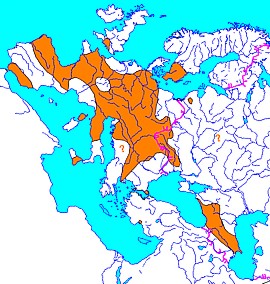|
 SCIENTIFIC
NAME: Myotis bechsteini Kuhl, 1817 SCIENTIFIC
NAME: Myotis bechsteini Kuhl, 1817
COMMON NAME: Bechstein's bat
SYNONYMS: ghidinii Fatio, 1902; favonicus Thomas,
1906.
SIZE: Body mass 6-12 g, head and body length 42-51 mm, tail length
40-46 mm, forearm length 39-45 mm, wingspan ca. 25-29 cm. DESCRIPTION:
Ear very long, exceeding half of head and body length, with broadly
rounded tip. Hind foot length with claws nearly equal to half of
tibia length. Wings wide, with grayish-brawn membranes. Muzzle relatively
long, with almost naked facial mask. Wing membrane attaches to the
basis of outer toe. Calcar lobe not developed. Fur long and thick,
grayish brawn dorsally and whitish-pale on the belly. Skull with
straight, not concaved frontal part and with very deep palatal emargination.
DISTRIBUTION: Europe from Spain and Great Britain to Poland and
Caucasus.
NATURAL HISTORY: Inhabits forested areas. Roosts in tree holes,
bat and bird boxes and various underground habitats. Often lives
solitary or in mixed aggregations with other bat species. Natural
history poorly investigated. Emergence take place late in the dusk;
flight is slow and composed. This bat forages not high from the
ground, over forest borders, clearings, flying round the trees and
bushes and frequently gleaning it's insect prey from various surfaces.
The echolocation calls are of low intensity, with the range of 80-35
kHz, and with maximum energy around 50 kHz. Births take places in
the beginning of summer. One newborn in a litter. Maternity colonies
consist of 10-20 females while males usually live separately. Non-migrating
species, hibernating in various underground roosts.
STATUS: Rare species. IUCN: "VU: A2c"
|






